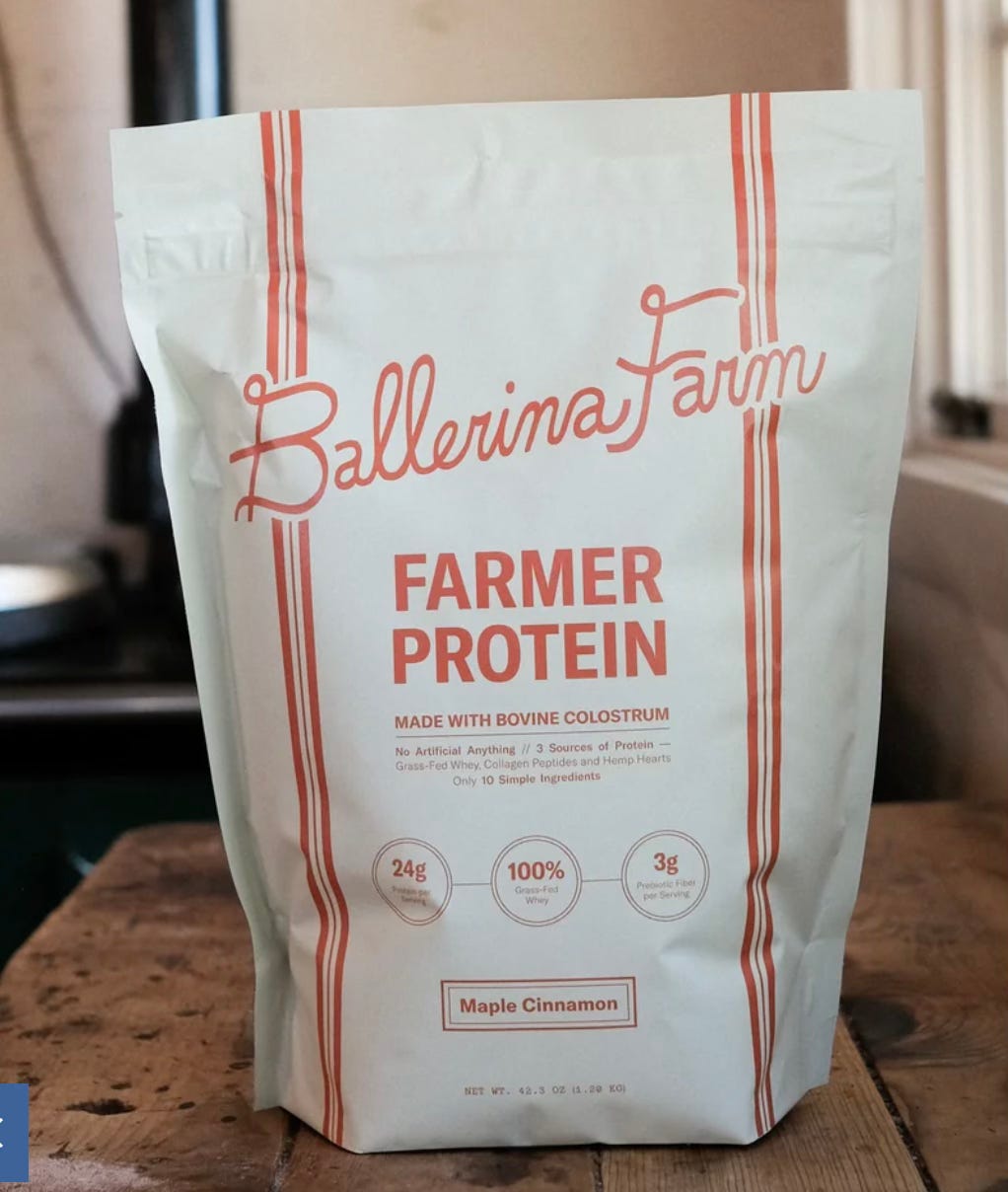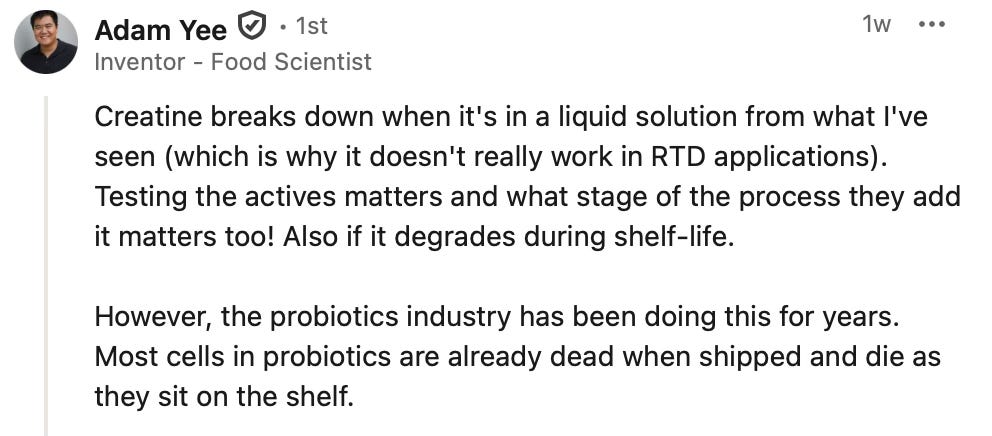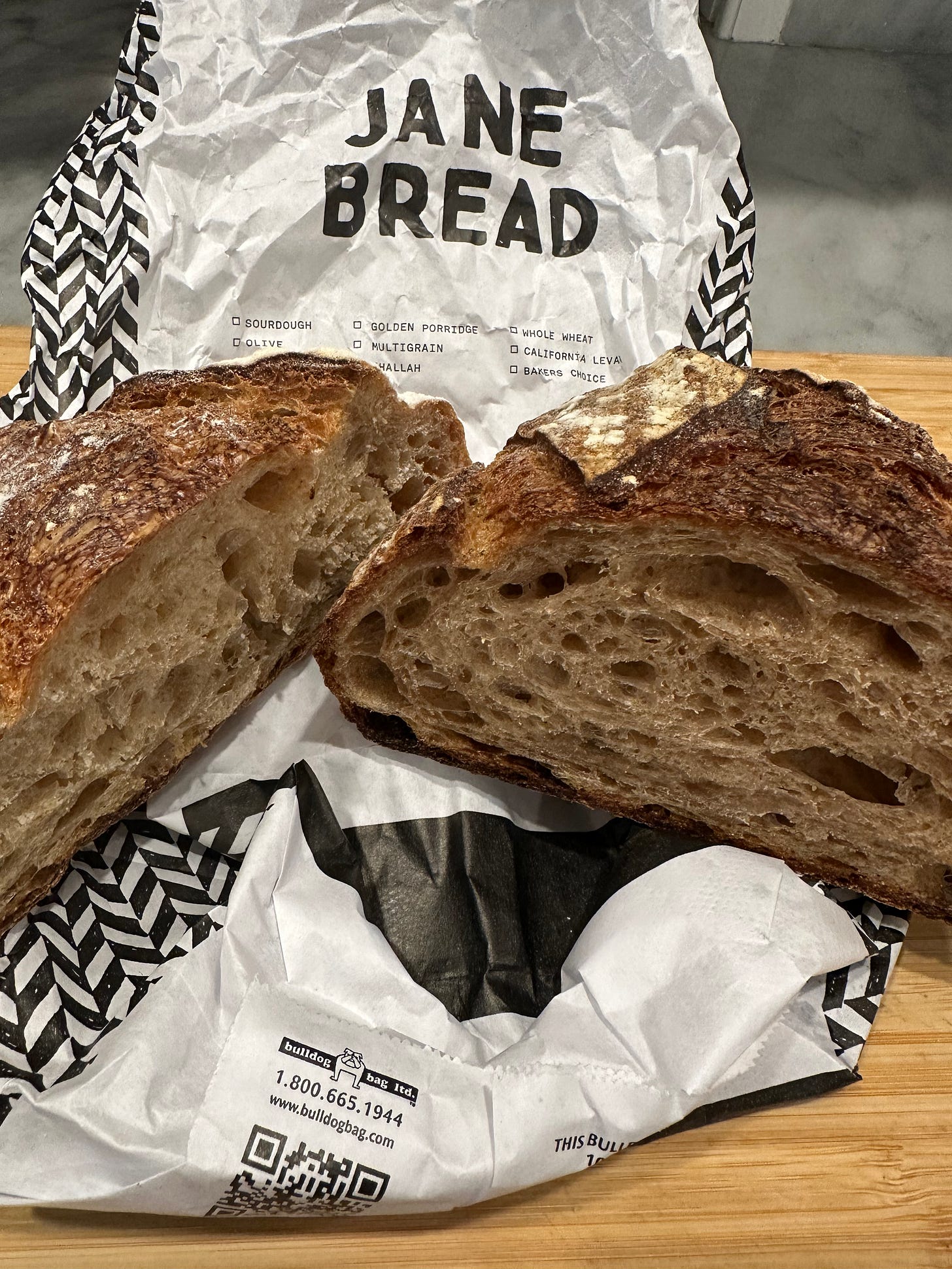Farmers' experiences with regenerative agriculture and the industry promoting it as a market opportunity
Every once in a while I hear from people trying to solve the regenerative ag problem as if it’s a market access problem. Startups building demand-pull platforms, networks, certification layers, or carbon marketplace overlays meant to unlock the value of regenerative agriculture. But in nearly every case, they’re solving the wrong problem.
Also in this post:
Protein powder blend with colostrum and collagen gone viral
Creatine as an ingredient?
What is happening to BigFood
Why bars are down
Don’t cut down on chocolate, replace it
Protein soft serve, with collagen and colostrum (but no creatine)
Last year I predicted colostrum would be the next functional food ingredient. Behold soft serve made with Ballerina Farm protein powder — 24g of protein with collagen and colostrum, in flavors vanilla, chocolate, strawberry and maple cinnamon. Now sold out on their website.
But why not go all the way and add creatine — because I’d really like to reduce the number of separate powders I’m taking.
Creatine as an ingredient is happening, but there could be formulaic limitations for things like RTD beverages, according to food scientist Adam Yee
We will soon have creatine cereal though!
BigFood is being dismantled before our eyes
Kellogg’s derivates don’t exist anymore and Kraft Heinz is coming apart. Del Monte went bk. What will replace the Mag 7 of food + bev? Insurgent brands, private label, and Mars (privately owned) is my bet.
CPGs stopped innovating and we are in for a whole new paradigm. The era of make-a-protein-version of your childhood cereal is over and the price/value proposition turns on its head. Clean, nutrient dense and tasty food is the new price value.
Whipstitch Capital has a great state of the industry you should check out if you want to understand capital markets and trends in M&A and private placements.
This is a funny idea you and I’d come up with over drinks but never actually do
In the absurdity of clean label compromises, we have a hyperbolic response. Get yours today —
Why bars are down
Shoppers are buying less groceries overall and switching (trading off), according to Big Chalk, who does a nice tear down at the macro level and specific categories. Their deep dive on bars shows that Protein Bar Consumers are cutting back and switching to things like nuts and jerky.
CPGs reformulating away from chocolate soon won’t have to
I interviewed Adam Maxwell the CEO and co-founder of Voyage Foods on this pod, a food-tech-turned CPG and ingredient company that’s partnered with Cargill to distribute their cocoa-free cocoa.
*New since this recording — the company is moving production from California to Ohio where they’ve built a large facility that will allow them to scale.
There is a disconnect between farmers' experiences with regenerative agriculture and the industry promoting it as a market opportunity
My pre-order of We Are Eating The Earth by Michael Grunwald arrived, and the part about regenerative ag was super interesting. In this book, and when I talk to farmers, I get examples of where the market for regenerative doesn’t exist at scale, and not in any way that justifies the risk and cost to farmers.
There’s a story of a brokered deal to Unilever for regenerative soy that fell through because Unilever’s premium was only 1% above market price. “Nobody will pay”, is becoming a recurring theme in the regenerative marketplace.
On a small scale, there’s a lot of support and it works — like with Bowles Farming’s regenerative wheat going to Jane the Bakery in SF. I stopped over to the bakery to get my bread. The bread is incredible —
When I reconnected with Cannon Michael, CEO of Bowles Farming, on the state of regenerative farming, he reiterated that although they’ve invested in many practices the regenerative industry claims to champion: large-scale composting, diverse rotations, cutting nitrogen use, trialing cover crops — the manufacturers and retailers surveyed by Cannon’s team expressed little to no demand for regenerative products. The only glimmer of traction came from a retailer interested in emissions tracking—leading to a potential six-figure deal.
Cannon’s experience raises serious questions about whether the frameworks being sold to brands and consumers are even grounded in the realities of farming in places like California, where food safety audits penalize biodiversity (cannot have ruminant poop droppings in the field). Water use, labor costs, and soils are completely different from the Midwestern regen case studies built around corn and wheat.
We Are Eating the Earth points out that ag incentives reward the expansion of land use—not efficiency or yield. Bioenergy and low-yield systems are framed as climate wins, but the models used to justify them (like the Greenhouse Gas Protocol) ignore the carbon opportunity cost of using land. Land is treated as free. Climate policy pretends all soil is neutral. So we subsidize practices that, on paper, look sustainable—but in practice often sprawl, displace ecosystems, and yield less food.
Which brings me back to those startups. They see a world of regenerative potential if only farmers could access the right buyers, get verified, get discovered. But that assumes demand already exists and just needs plumbing. It doesn’t. The regen boom is being driven by branding departments, not supply chain budgets. Until that changes, all the tokenization, tracing, and storytelling in the world won’t bridge the gap.
So yes, regenerative agriculture has a role to play. And yes, farmers like Cannon are already doing the work. But if we want it to scale beyond pilots we need to stop pretending this is a market-ready movement. It’s a theory in search of economics.
All my best,
Jennifer














